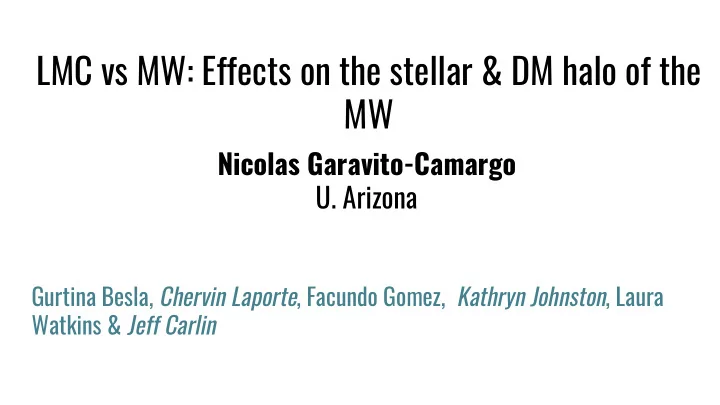

LMC vs MW: Effects on the stellar & DM halo of the MW Nicolas Garavito-Camargo U. Arizona Gurtina Besla, Chervin Laporte , Facundo Gomez, Kathryn Johnston , Laura Watkins & Jeff Carlin
The LMC is the biggest perturber of the MW’s halo. Currently, just passed its pericenter. 50 kpc ESA/Gaia/DPAC LMC vs MW: Nico Garavito-Camargo
The LMC is the biggest perturber of the MW’s halo. Currently, just passed its pericenter. Very rare configuration to find in cosmological simulations (Boylan-Kolchin+11 , Busha+11, Patel+17, Shao+18, ) 50 kpc ESA/Gaia/DPAC LMC vs MW: Nico Garavito-Camargo
The LMC is big! Besla+16, Mackey+16. See also: Balbinot et al 2015, Saha et al 2010. LMC vs MW: Nico Garavito-Camargo
The LMC is big! LMC Estimated mass: ~10 11 M ☉ LMC rotation curve : ● Total mass (<9 kpc): 1.7 x 10 10 M ☉ (van der Marel & Kallivayalil 2014) Total mass (<20 kpc): 3 x 10 10 M ☉ Baryon Fraction (3-5%): ● LMC M ★ : ~ 3x10 9 M ☉ -> M DM 0.5 - 1 x 10 11 M ☉ (van der Marel+09) Timing argument: 2.5x 10 11 M ☉ ● (Peñarrubia+16) In EAGLE simulation LMC with SMC are found to ● have ~3x10 11 M ☉ (Shao+18) Besla+16, Mackey+16. See also: Balbinot et al 2015, Saha et al 2010. LMC vs MW: Nico Garavito-Camargo
1. At what radius does the LMC affect the stellar & DM halo of the MW? LMC vs MW: Nico Garavito-Camargo
1. At what radius does the LMC affect the stellar & DM halo of the MW? 2. What are the consequences (in density and kinematics) for the DM & stellar halo? LMC vs MW: Nico Garavito-Camargo
1. At what radius does the LMC affect the stellar & DM halo of the MW? 2. What are the consequences (in density and kinematics) for the DM & stellar halo? 3. What are the observables of these effects? LMC vs MW: Nico Garavito-Camargo
8 high-resolution N-body simulations 1 of the LMC in a first infall scenario LMC on first passage, infall DM Mass ~ 10 11 M ☉ ● MW DM halo initially spherical + MW Disk & Bulge ● Garavito-Camargo, Besla et. al in prep MW mass M vir = 1.2x10 12 M ☉ ● Two stellar halos density profiles (Xue,+15, ● Hernitschek+18) added using a DM halo tagging technique Laporte+13a, 13b. Combined DM halo (LMC+MW) is not spherical, oblate, prolate or triaxial. 1 N-body sims run with GADGET-3 LMC vs MW: Nico Garavito-Camargo
Milky Way’s DM halo response & wake evolves in time. Garavito-Camargo, Besla et. al in prep LMC vs MW: Nico Garavito-Camargo
Dark Matter halo response in the stellar halo is stronger at r>40 kpc. LMC vs MW: Nico Garavito-Camargo Garavito-Camargo, Besla et. al in prep
Dark Matter halo response in the stellar halo is stronger at r>40 kpc. LMC vs MW: Nico Garavito-Camargo Garavito-Camargo, Besla et. al in prep
Dark Matter halo response in the stellar halo is stronger at r>40 kpc. LMC vs MW: Nico Garavito-Camargo Garavito-Camargo, Besla et. al in prep
Dark Matter halo response in the stellar halo is stronger at r>40 kpc. LMC vs MW: Nico Garavito-Camargo Garavito-Camargo, Besla et. al in prep
The strength of the DM wake depends on the kinematics of the DM halo (Also found by Nicola Amorisco). Isotropic Model Anisotropic Model Garavito-Camargo, Besla et. al in prep LMC vs MW: Nico Garavito-Camargo
Stellar Halo Kinematics: Tangential Velocity Dispersion responds to the LMC anisotropically. Changing by as much as 20-30 km/s relative to the all-sky average. Garavito-Camargo, Besla et. al in prep The same is observed in the radial component. LMC vs MW: Nico Garavito-Camargo
Stellar halo kinematics as a tracer of the DM halo response. �� r ��� ��� �� LMC vs MW: Nico Garavito-Camargo
Observational strategies to observe the DM halo response: At r>50 kpc and avoid Sgr . LMC vs MW: Nico Garavito-Camargo Plot made using: GALSTREAMS (Mateu+17)
Observational strategies to observe the DM halo response: At r>50 kpc and avoid Sgr . Garavito-Camargo, Besla et. al in prep LMC vs MW: Nico Garavito-Camargo Plot made using: GALSTREAMS (Mateu+17)
Observational strategies to observe the DM halo response: At r>50 and avoid Sgr . Garavito-Camargo, Besla et. al in prep LMC vs MW: Nico Garavito-Camargo Plot made using: GALSTREAMS (Mateu+17)
Conclusions: LMC is massive and near pericenter, making it hard to study in existing cosmological simulations. 1. Preliminary work (idealized Nbody) shows that within 40 kpc the LMC’s impact is minimal. 2. Outside 40 kpc, the LMC should leave an observational imprint, both trailing and leading its current location. Imprints are both density enhancements and kinematic perturbations. 3. The kinematics of the stellar halo traces the DM halo response. 4. We are making predictions for observations. (If you are interested please come talk to me) The time evolution of the DM halo potential owing to the LMC is also in progress. LMC vs MW: Nico Garavito-Camargo: jngaravitoc@email.arizona.edu
Combined MW+LMC DM halo potential evolving in time.
The LMC orbit doesn’t change with LMC mass.
Recommend
More recommend